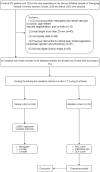Development and validation of a predictive risk model based on retinal geometry for an early assessment of diabetic retinopathy
- PMID: 36479215
- PMCID: PMC9719996
- DOI: 10.3389/fendo.2022.1033611
Development and validation of a predictive risk model based on retinal geometry for an early assessment of diabetic retinopathy
Abstract
Aims: This study aimed to develop and validate a risk nomogram prediction model based on the retinal geometry of diabetic retinopathy (DR) in patients with type 2 diabetes mellitus (T2DM) and to investigate its clinical application value.
Methods: In this study, we collected the clinical data of 410 patients with T2DM in the Second Affiliated Hospital of Chongqing Medical University between October 2020 and March 2022. Firstly, the patients were randomly divided into a development cohort and a validation cohort in a ratio of 7:3. Then, the modeling factors were selected using the least absolute shrinkage and selection operator (LASSO). Subsequently, a nomogram prediction model was built with these identified risk factors. Two other models were constructed with only retinal vascular traits or only clinical traits to confirm the performance advantage of this nomogram model. Finally, the model performances were assessed using the area under the receiver operating characteristic curve (AUC), calibration plot, and decision curve analysis (DCA).
Results: Five predictive variables for DR among patients with T2DM were selected by LASSO regression from 33 variables, including fractal dimension, arterial tortuosity, venular caliber, duration of diabetes mellitus (DM), and insulin dosage (P< 0.05). A predictive nomogram model based on these selected clinical and retinal vascular factors presented good discrimination with an AUC of 0.909 in the training cohort and 0.876 in the validation cohort. By comparing the models, the retinal vascular parameters were proven to have a predictive value and could improve diagnostic sensitivity and specificity when combined with clinical characteristics. The calibration curve displayed high consistency between predicted and actual probability in both training and validation cohorts. The DCA demonstrated that this nomogram model led to net benefits in a wide range of threshold probability and could be adapted for clinical decision-making.
Conclusion: This study presented a predictive nomogram that might facilitate the risk stratification and early detection of DR among patients with T2DM.
Keywords: T2DM; diabetic retinopathy; nomogram; prediction model; retinal geometry.
Copyright © 2022 Wang, Zhou, Liu, Chen, Zheng and Ling.
Conflict of interest statement
Author SL is employed by EVision technology Beijing co.LTD, China. The remaining authors declare that the research was conducted in the absence of any commercial or financial relationships that could be construed as a potential conflict of interest.
Figures






Similar articles
-
Nomogram Prediction for the Risk of Diabetic Foot in Patients With Type 2 Diabetes Mellitus.Front Endocrinol (Lausanne). 2022 Jul 13;13:890057. doi: 10.3389/fendo.2022.890057. eCollection 2022. Front Endocrinol (Lausanne). 2022. PMID: 35909507 Free PMC article.
-
Nomogram for prediction of diabetic retinopathy in patients with type 2 diabetes mellitus: A retrospective study.J Diabetes Complications. 2022 Nov;36(11):108313. doi: 10.1016/j.jdiacomp.2022.108313. Epub 2022 Sep 21. J Diabetes Complications. 2022. PMID: 36183450
-
Development and external validation of a predictive model for type 2 diabetic retinopathy.Sci Rep. 2024 Jul 20;14(1):16741. doi: 10.1038/s41598-024-67533-5. Sci Rep. 2024. PMID: 39033211 Free PMC article.
-
Diabetic retinopathy risk prediction in patients with type 2 diabetes mellitus using a nomogram model.Front Endocrinol (Lausanne). 2022 Nov 16;13:993423. doi: 10.3389/fendo.2022.993423. eCollection 2022. Front Endocrinol (Lausanne). 2022. PMID: 36465620 Free PMC article.
-
Predicting vision-threatening diabetic retinopathy in patients with type 2 diabetes mellitus: Systematic review, meta-analysis, and prospective validation study.J Glob Health. 2024 Oct 11;14:04192. doi: 10.7189/jogh.14.04192. J Glob Health. 2024. PMID: 39391902 Free PMC article.
Cited by
-
Risk Factors for Diabetic Retinopathy in Latin America (Mexico) and the World: A Systematic Review and Meta-Analysis.J Clin Med. 2023 Oct 18;12(20):6583. doi: 10.3390/jcm12206583. J Clin Med. 2023. PMID: 37892721 Free PMC article.
-
Initiation of China Alliance of Research in High Myopia (CHARM): protocol for an AI-based multimodal high myopia research biobank.BMJ Open. 2023 Dec 27;13(12):e076418. doi: 10.1136/bmjopen-2023-076418. BMJ Open. 2023. PMID: 38151272 Free PMC article.
-
Advances in Structural and Functional Retinal Imaging and Biomarkers for Early Detection of Diabetic Retinopathy.Biomedicines. 2024 Jun 25;12(7):1405. doi: 10.3390/biomedicines12071405. Biomedicines. 2024. PMID: 39061979 Free PMC article. Review.
-
Quantitative Assessment of Fundus Tessellated Density in Highly Myopic Glaucoma Using Deep Learning.Transl Vis Sci Technol. 2024 Apr 2;13(4):17. doi: 10.1167/tvst.13.4.17. Transl Vis Sci Technol. 2024. PMID: 38591943 Free PMC article.
-
Quantitative analysis of optic disc changes in school-age children with ametropia based on artificial intelligence.Int J Ophthalmol. 2023 Nov 18;16(11):1727-1733. doi: 10.18240/ijo.2023.11.01. eCollection 2023. Int J Ophthalmol. 2023. PMID: 38028515 Free PMC article.
References
Publication types
MeSH terms
Substances
LinkOut - more resources
Full Text Sources
Medical

